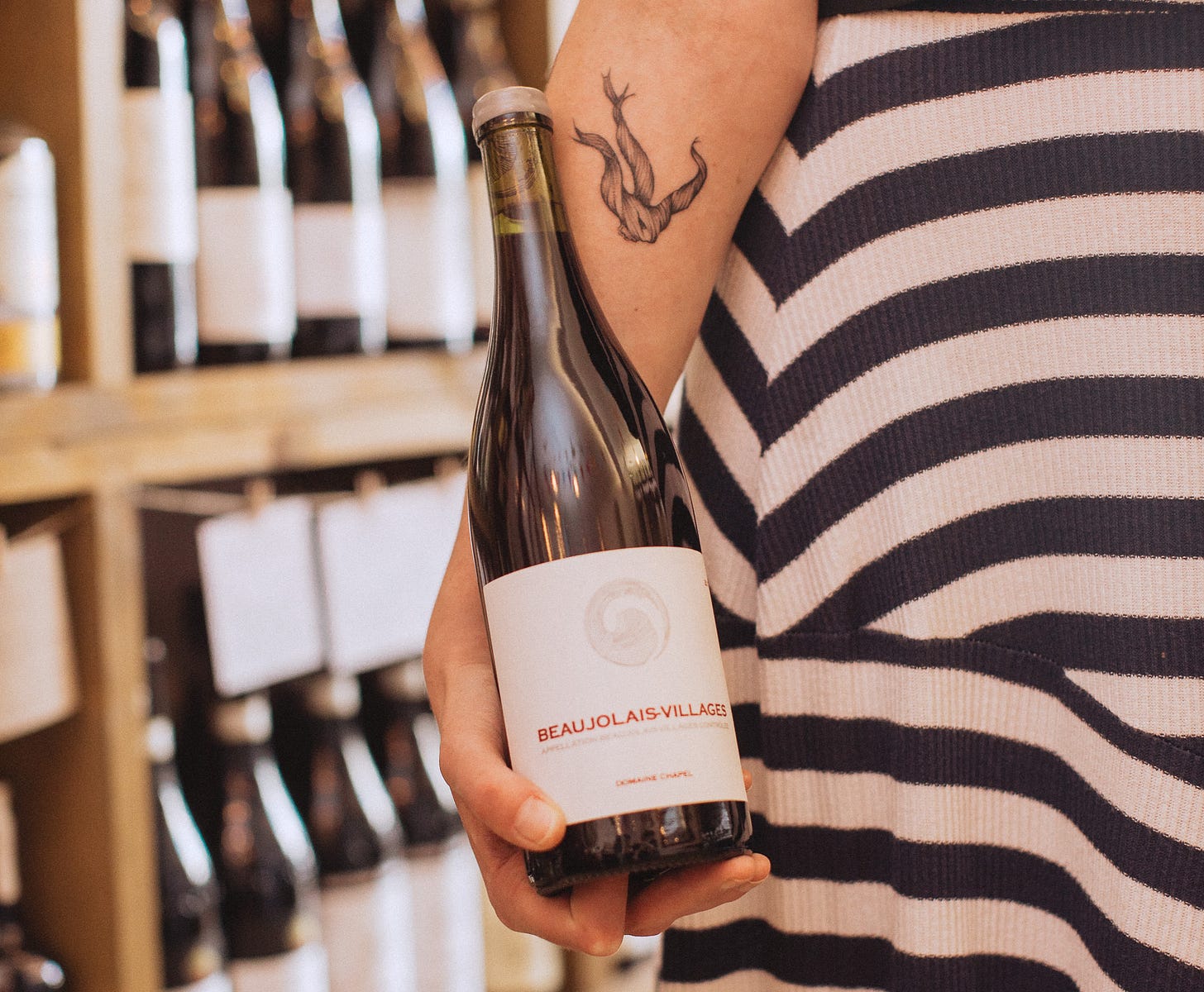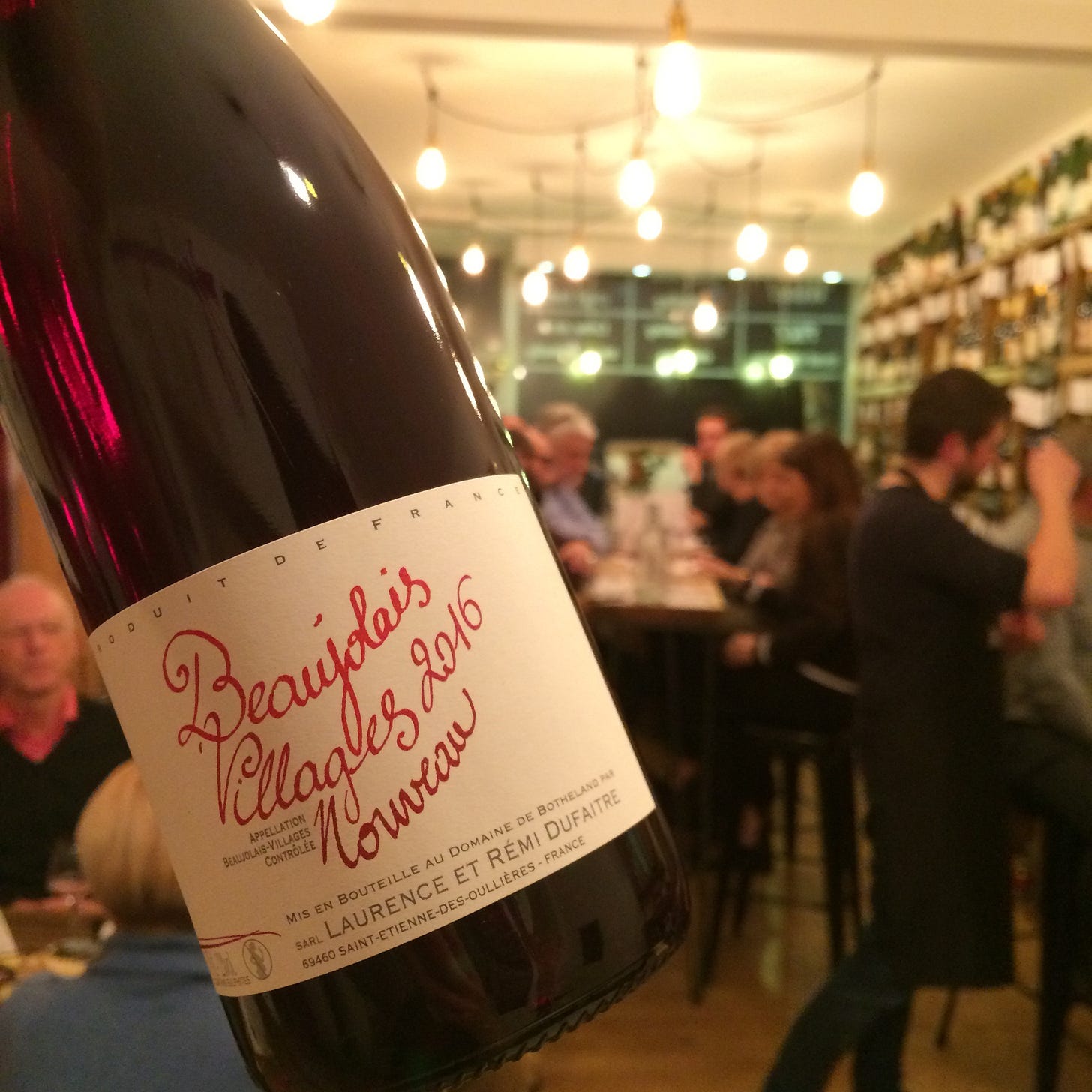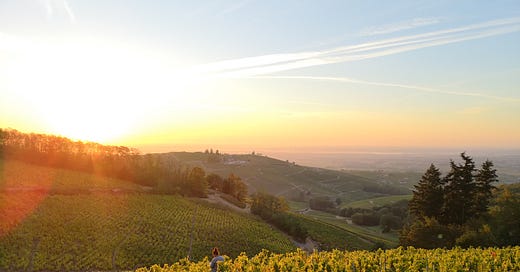There is nothing — and I mean nothing — quite like sunrise in Beaujolais. This is one of the most beautiful wine regions in France. Burgundy may have the caché. Bordeaux may have the beautiful chateaux.
But Beaujolais has the soul.
Ever since I spent a weekend holed up in a caravan in Beaujolais with three dudes whose thirst for Beaujolais was arguably even greater than mine, it has taken me hook, line and sinker.
Follow that with working a few weeks’ grape harvest at the brilliant Domaine Chapel —where the above sunrise picture was taken — and you’ve got a lifelong convert, with the Beaujolais old bush vine tattoo to prove it.

But whilst Beaujolais may be like crack to many young, hip Somms, the general public often thinks otherwise. Talk to any punter off the street (back in my wine store days, I frequently did) and you’ll often hear the same three answers:
Beaujolais is too light and it can’t age. It’s not a serious wine.
Isn’t Beaujolais all natural BS now?
Ah Beaujolais Nouveau, I remember it from the 1980s. Fun times, crap wine.
All three of these have a nugget of truth. Yes, Beaujolais is a lighter style of wine. Yes, it’s home to a huge natural wine movement. And yes, Beaujolais Nouveau was massive in the 1980s.
But that’s as far as the truth in these statements goes. It can age. It’s not all BS. And Beaujolais Nouveau doesn’t have to be crap.
Tomorrow — 21st November 2024 — is the third Thursday in November which means it’s Beaujolais Nouveau day. The day when the first wines from this year’s Beaujolais harvest arrive on our shelves and in our restaurants. And if you’re interested in wine, that makes it a very fun day indeed.
Not ready to make a paid commitment to The Sauce? A one-off donation also keeps the lights on and the Beaujolais Nouveau flowing
Britain is home to the Beaujolais Nouveau run. For those of you unaware of this rather eccentric cultural touchstone, it was invented in 1973 by a London-based journalist. He challenged fellow writers to be the first to bring him back a bottle of Beaujolais.
From southeastern France to London as quickly as possible.
By the 1980s, the run had taken Britain by storm. British restaurants, wine merchants and lushes with a taste for the gouty things in life would buy Nouveau in Beaujolais itself at midnight on the third Thursday of November (it’s illegal to release it before then). They would then race through the night to be the first to get the wines on their clients’ tables by morning.
Breakfast on those third Thursdays in November must have been a lively affair.
My friend (one of those in the caravan) told me his dad once did the run and it sounded terrifying. Put it this way — there was a lot of fast driving in old cars that shouldn’t be driven fast. And a lot of something that goes up your nose to keep you awake.
Ah, the eighties. What a time to be alive.
Whilst the Beaujolais run is not such a big thing anymore (although another friend of mine is taking part in it this year), it cemented the idea that Beaujolais is a fun wine but nothing to be taken too seriously — be that Nouveau or other.
The wine also suffers (in old-school circles at least) from the fact that it’s made with a winemaking method called Carbonic Maceration.
I won’t go into geeky specifics but in short, carbonic maceration happens when, instead of crushing the grapes before fermentation (as is more common), whole bunches go into a vat. That vat is topped up with carbon dioxide and sealed shut. This forces the fermentation to start within the berry which results in a lighter style of wine with lower tannins.
The alleged problem with carbonically macerated wines is that their naysayers will tell you all of them taste the same.
I say that if they think that, they’re not trying very hard. Because if you spend long enough drinking enough Beaujolais, you can taste the differences between different levels, villages, and even vineyards.
With the good stuff, terroir trumps carbonic maceration every single time.
Then there’s the natural wine argument — a blessing or a curse depending on who you talk to.
It’s true that Beaujolais is arguably the home of natural wine. This is thanks to four winemakers who made it their mission in the 1980s to buck the trend of industrially made wine. They started to farm without chemicals in the vineyards and kept intervention in the cellar to a minimum.
The gang spurred a movement that had a huge influence on the shape of Beaujolais today. All these bright young winemakers are making bright young — and yes, natural — wines thanks to those original four.
Granted, some aren’t good wines because this is winemaking and you never hit bullseye 100% of the time. But many (or even most) are good, to excellent, to I will murder my family for a bottle.
Beaujolais may have suffered under the weight of its slightly weird and changeable reputation (and that many people conflate Beaujolais with Beaujolais Nouveau). But if we put that aside, we can find a very special — very fun — winemaking region that is responsible for arguably some of the best parties you’ll ever find yourself a part of.
Don’t believe me? If you can, find a Nouveau party tomorrow evening (many natural wine bars will have something going on) and find out for yourself.
Oh, you ARE ready to make a paid commitment to The Sauce! How wonderful. $5 a month or $50 a year gives you access to everything I write, from in-depth travel guides to food culture essays to recipes.
The region of Beaujolais shows that wine doesn’t have to take itself seriously to be seriously good. It shows that wine doesn’t have to be full-bodied to be complex. And it shows that when it comes to wine, you shouldn’t believe everything a posh dude in a gold-buttoned blazer tells you.
And whilst Beaujolais Nouveau wines aren’t traditionally complex or age-worthy, they have a place in the wine world. A very important place.
Because Beaujolais Nouveau has become more popular — especially amongst young wine drinkers who don’t know or care about its poor reputation — it’s possible to find the best names in Beaujolais releasing Nouveau as their contribution to the party.
Names like Jean Foillard. Chamonard. Séléné. Rémi Dufaitre. All amazing producers, all into Nouveau.
Their Nouveaux are good. Yes, they’re very young and will stain your teeth purple. Yes, they will not age well because they’re not designed to.
But at the risk of sounding cheesy, they are full of joie de vivre. Especially if they are drunk whilst propping up a Paris wine bar. Or drinking with other Beaujolais-heads. Or washing down an obscenely-sized platter of of French cheese and meats on your own in the kitchen.

At the heart of it, Beaujolais Nouveau is a celebration of harvest. It’s a way to give thanks to the earth — the one that gives up something so winemakers can put food on the table and wine in their glass.
Long live Beaujolais Nouveau. I’ll be raising a bottle to your wonderfully young and delicious ways tomorrow. I’d love you to join me.





I loved reading this. For a brief moment, I could hear the lively chatter in the streets of the old city of Lyon and see the lovely countryside you describe so well, and taste the smooth strawberry light Beaujolais.
It was so good to read this. My father couldn't wait for the Beaujolais to hit the shelves. He would have been 94 this year. He turned me and my husband into fans. We've thought about taking a trip to the Beaujolais region in his honor.